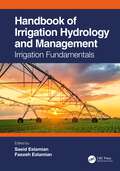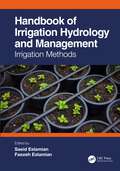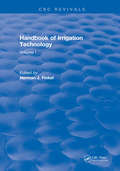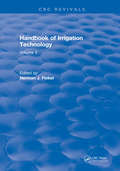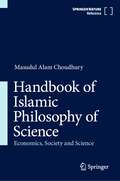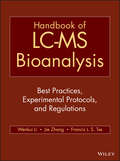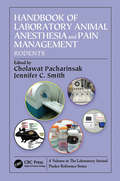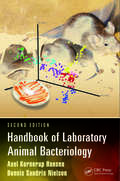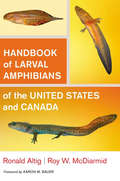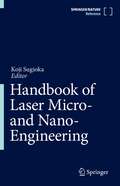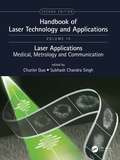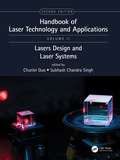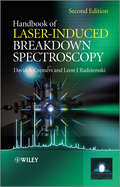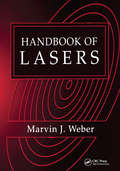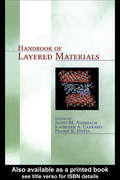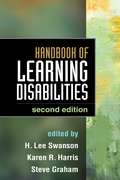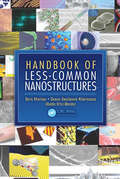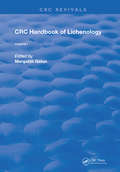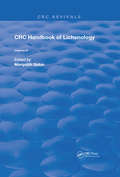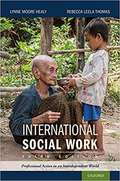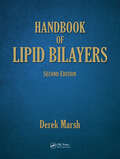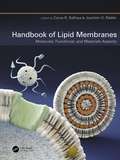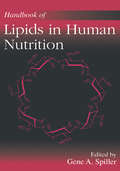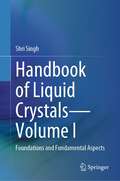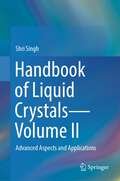- Table View
- List View
Handbook of Irrigation Hydrology and Management: Irrigation Fundamentals
by Saeid Eslamian Faezeh EslamianEver-increasing population growth has caused a proportional increased demand for water, and existing water sources are depleting day by day. Moreover, with the impact of climate change, the rates of rainfall in many regions have experienced a higher degree of variability. In many cities, government utilities have been struggling to maintain sufficient water for the residents and other users. The Handbook of Irrigation Hydrology and Management examines and analyzes irrigated ecosystems in which water storage, applications, or drainage volumes are artificially controlled in the landscape and the spatial domain of processes varies from micrometers to tens of kilometers, while the temporal domain spans from seconds to centuries. The continuum science of irrigation hydrology includes the surface, subsurface (unsaturated and groundwater systems), atmospheric, and plant subsystems. Further, the book includes coverage of environmental and economic impacts, water quality issues, water harvesting, satellite measurements for irrigation, and more. Features: Offers water-saving strategies to increase the judicious use of scarce water resources Presents strategies to maximize agricultural yield per unit of water used for different regions Compares irrigation methods to offset changing weather patterns and impacts of climate change
Handbook of Irrigation Hydrology and Management: Irrigation Methods
by Saeid Eslamian Faezeh EslamianEver-increasing population growth has caused a proportional increased demand for water, and existing water sources are depleting day by day. Moreover, with the impact of climate change, the rates of rainfall in many regions have experienced a higher degree of variability. In many cities, government utilities have been struggling to maintain sufficient water for the residents and other users. The Handbook of Irrigation Hydrology and Management: Irrigation Methods examines and analyzes irrigated ecosystems in which water storage, applications, or drainage volumes are artificially controlled in the landscape and the spatial domain of processes varies from micrometers to tens of kilometers, while the temporal domain spans from seconds to centuries. The continuum science of irrigation hydrology includes the surface, subsurface (unsaturated and groundwater systems), atmospheric, and plant subsystems. Further, the book addresses the best practices for various types of irrigation methods including pressure, smart, surface, and subsurface, and presents solutions for water scarcity and soil salinity in irrigation.Features: Offers water-saving strategies to increase the judicious use of scarce water resources Presents strategies to maximize agricultural yield per unit of water used for different regions Compares irrigation methods to offset changing weather patterns and impacts of climate change
Handbook of Irrigation Technology: Volume 1
by Herman J. FinkelThis title was first published in 1982: Overview of Irrigation
Handbook of Irrigation Technology: Volume 2
by herman J. FinkelThis book was first published in 1983. It provides a comprehensive overview of irrigation technologies, techniques and economics, tailored to a multitude of different crops.
Handbook of Islamic Philosophy of Science: Economics, Society and Science
by Masudul Alam ChoudhuryThis handbook provides a comprehensive overview of Islamic ethical issues within a wide spectrum of philosophy of science topics, examining the development of the model of moral inclusiveness in economics, science and society from ontological, epistemological and analytical perspectives. This paradigm takes the view that ethics is systemically endogenous, and can be studied by the most rigorous scientific analysis pertaining to diverse issues and problems of ethicality in socio-scientific inquiry. This handbook takes a sweeping transdisciplinary approach that is deeply phenomenological, to the nature and logic of scientific inquiry of, and in, the Qur’an. Such an approach invokes the episteme of the unity of knowledge in the socio-scientific systemic sense. The volumes' respective sections focus on the nature, logic, and role that ethics plays in formulating new vistas of alternative epistemic futures in Islamic economics, finance, and the social sciences. The ideas presented are situated within the broader context of the post-modernist, post-pandemic, and the post-Covid-19 epoch, while being aimed at conceptualising a distinctive new outlook of transdisciplinary intellection in Islamic philosophy. The content is rigorously conceptual, qualitative, quantitative, and applied. Covering a diversity of subject areas from philosophy of science, to economics and in socio-scientific context within the realm of Islamic philosophy, this forms a key text for scholars in these respective arenas, led by pioneering scholarship in Islamic studies.
Handbook of LC-MS Bioanalysis
by Francis L. Tse Jie Zhang Wenkui LiConsolidates the information LC-MS bioanalytical scientists need to analyze small molecules and macromoleculesThe field of bioanalysis has advanced rapidly, propelled by new approaches for developing bioanalytical methods, new liquid chromatographic (LC) techniques, and new mass spectrometric (MS) instruments. Moreover, there are a host of guidelines and regulations designed to ensure the quality of bioanalytical results.Presenting the best practices, experimental protocols, and the latest understanding of regulations, this book offers a comprehensive review of LC-MS bioanalysis of small molecules and macromolecules. It not only addresses the needs of bioanalytical scientists working on routine projects, but also explores advanced and emerging technologies such as high-resolution mass spectrometry and dried blood spot microsampling.Handbook of LC-MS Bioanalysis features contributions from an international team of leading bioanalytical scientists. Their contributions reflect a review of the latest findings, practices, and regulations as well as their own firsthand analytical laboratory experience. The book thoroughly examines:Fundamentals of LC-MS bioanalysis in drug discovery, drug development, and therapeutic drug monitoringThe current understanding of regulations governing LC-MS bioanalysisBest practices and detailed technical instructions for LC-MS bioanalysis method development, validation, and stability assessment of analyte(s) of interestExperimental guidelines and protocols for quantitative LC-MS bioanalysis of challenging molecules, including pro-drugs, acyl glucuronides, N-oxides, reactive compounds, and photosensitive and autooxidative compoundsWith its focus on current bioanalytical practice, Handbook of LC-MS Bioanalysis enables bioanalytical scientists to develop and validate robust LC-MS assay methods, all in compliance with current regulations and standards.
Handbook of Laboratory Animal Anesthesia and Pain Management: Rodents (Laboratory Animal Pocket Reference)
by Cholawat Pacharinsak Jennifer C. SmithKey features: Presents practical information in easily accessible ‘bullet point’ format Covers anesthetic machine and related equipment, anesthetic management and monitoring, anesthesia and analgesia pharmacology, euthanasia, and record keeping Written by well-recognized experts in the laboratory animal community Provides extensive references to direct the reader to sources for further study of alternative techniques and their procedures Concludes with a thorough chapter on Regulatory Management of Rodent Anesthesia which has global application Rodents are the most commonly used species in biomedical research. Individuals conducting rodent research are often responsible to ensure that all areas of anesthesia and analgesia are performed humanely. Anesthetic agent selection, anesthetic monitoring, and postoperative pain assessment and management are essential to the institutional animal care and use program and contribute significantly to the 3Rs by reducing pain and/or distress and refining various procedures. The Handbook of Laboratory Animal Anesthesia and Pain Management: Rodents is the first book to capture multiple advances in this important area that greatly impacts various experimental methodologies. Richly illustrated in full color, the book serves as a quick reference source for investigators, veterinarians, technicians, and other animal caretakers charged with the care and use of rodents in a research setting. The unique format of this book also makes it extremely valuable to IACUC members, institutional officials, and occupational health and safety professionals.
Handbook of Laboratory Animal Bacteriology
by Axel Kornerup Hansen Dennis Sandris NielsenThe Handbook of Laboratory Animal Bacteriology, Second Edition provides comprehensive information on all bacterial phylae found in laboratory rodents and rabbits to assist managers, veterinary pathologists and laboratory animal veterinarians in the management of these organisms. The book starts by examining the general aspects of bacteriology and h
Handbook of Larval Amphibians of the United States and Canada
by Ronald Altig Roy W. Mcdiarmid Aaron M. BauerGenerously illustrated, this essential handbook for herpetologists, ecologists, and naturalists features comprehensive keys to eggs, embryos, salamander larvae, and tadpoles; species accounts; a glossary of terms; and an extensive bibliography. The taxonomic accounts include a summarization of the morphology and basic natural history, as well as an introduction to published information for each species. Tadpole mouthparts exhibit major characteristics used in identifications, and the book includes illustrations for a number of species. Color photographs of larvae of many species are also presented. Handbook of Larval Amphibians of the United States and Canada, written by the foremost experts on larval amphibians, is the first guide of its kind and will transform the fieldwork of scientists and fish and wildlife professionals.
Handbook of Laser Micro- and Nano-Engineering
by Koji SugiokaThis handbook provides a comprehensive review of the entire field of laser micro and nano processing, including not only a detailed introduction to individual laser processing techniques but also the fundamentals of laser-matter interaction and lasers, optics, equipment, diagnostics, as well as monitoring and measurement techniques for laser processing. Consisting of 11 sections, each composed of 4 to 6 chapters written by leading experts in the relevant field. Each main part of the handbook is supervised by its own part editor(s) so that high-quality content as well as completeness are assured. The book provides essential scientific and technical information to researchers and engineers already working in the field as well as students and young scientists planning to work in the area in the future. Lasers found application in materials processing practically since their invention in 1960, and are currently used widely in manufacturing. The main driving force behind this fact is that the lasers can provide unique solutions in material processing with high quality, high efficiency, high flexibility, high resolution, versatility and low environmental load. Macro-processing based on thermal process using infrared lasers such as CO2 lasers has been the mainstream in the early stages, while research and development of micro- and nano-processing are becoming increasingly more active as short wavelength and/or short pulse width lasers have been developed. In particular, recent advances in ultrafast lasers have opened up a new avenue to laser material processing due to the capabilities of ultrahigh precision micro- and nanofabrication of diverse materials. This handbook is the first book covering the basics, the state-of-the-art and important applications of the dynamic and rapidly expanding discipline of laser micro- and nanoengineering. This comprehensive source makes readers familiar with a broad spectrum of approaches to solve all relevant problems in science and technology. This handbook is the ultimate desk reference for all people working in the field.
Handbook of Laser Technology and Applications: Laser Applications: Medical, Metrology and Communication (Volume Four) (Handbook of Laser Technology and Applications #4)
by Chunlei Guo Subhash Chandra SinghThis comprehensive handbook gives a fully updated guide to lasers and laser technologies, including the complete range of their technical applications. This forth volume covers laser applications in the medical, metrology and communications fields. Key Features: • Offers a complete update of the original, bestselling work, including many brand-new chapters. • Deepens the introduction to fundamentals, from laser design and fabrication to host matrices for solid-state lasers, energy level diagrams, hosting materials, dopant energy levels, and lasers based on nonlinear effects. • Covers new laser types, including quantum cascade lasers, silicon-based lasers, titanium sapphire lasers, terahertz lasers, bismuth-doped fiber lasers, and diode-pumped alkali lasers. • Discusses the latest applications, e.g., lasers in microscopy, high-speed imaging, attosecond metrology, 3D printing, optical atomic clocks, time-resolved spectroscopy, polarization and profile measurements, pulse measurements, and laser-induced fluorescence detection. • Adds new sections on laser materials processing, laser spectroscopy, lasers in imaging, lasers in environmental sciences, and lasers in communications. This handbook is the ideal companion for scientists, engineers, and students working with lasers, including those in optics, electrical engineering, physics, chemistry, biomedicine, and other relevant areas.
Handbook of Laser Technology and Applications: Laser Design and Laser Systems (Volume Two) (Handbook of Laser Technology and Applications #2)
by Chunlei Guo Subhash Chandra SinghThis comprehensive handbook gives a fully updated guide to lasers and laser systems, including the complete range of their technical applications. The first volume outlines the fundamental components of lasers, their properties and working principles. The second volume gives exhaustive coverage of all major categories of lasers, from solid-state and semiconductor diode to fiber, waveguide, gas, chemical, and dye lasers. The third volume covers modern applications in engineering and technology, including all new and updated case studies spanning telecommunications and data storage to medicine, optical measurement, defense and security, nanomaterials processing and characterization.
Handbook of Laser-Induced Breakdown Spectroscopy
by Leon J. Radziemski David A. CremersStarting from fundamentals and moving through a thorough discussion of equipment, methods, and techniques, the Handbook of Laser-Induced Breakdown Spectroscopy provides a unique reference source that will be of value for many years to come for this important new analysis method. The authors, with a total of over 60 years of experience in the LIBS method, use a combination of tutorial discussions ranging from basic principles up to more advanced descriptions along with extensive figures and photographs to clearly explain topics addressed in the text. In this second edition, chapters on the use of statistical analysis and advances in detection of weapons of mass destruction have been added. Tables of data related to analysis with LIBS have been updated. The Handbook of Laser-Induced Breakdown Spectroscopy, Second Edition:provides a thorough but understandable discussion of the basic principles of the method based on atomic emission spectroscopy, including recently available data leading to better characterization of the LIBS plasma;presents a discussion of the many advantages of the method along with limitations, to provide the reader a balanced overview of capabilities of the method;describes LIBS instrumentation ranging from basic set-ups to more advanced configurations;presents a comprehensive discussion of the different types of components (laser, spectrometers, detectors) that can be used for LIBS apparatuses along with suggestions for their use, as well as an up-to-date treatment of the newest advances and capabilities of LIBS instruments;presents the analytical capabilities of the method in terms of detection limits, accuracy, and precision of measurements for a variety of different sample types;discusses methods of sampling different media such as gases, liquids, and solids;presents an overview of some real-world applications of the method, with new emphasis on sampling of biologically and physically dangerous materials;provides an up-to-date list of references to LIBS literature along with the latest detection limits and a unique list of element detection limits using a uniform analysis method;provides annotated examples of LIBS spectra which can serve as references for the general reader and will be especially useful for those starting out in the field.
Handbook of Lasers: Theory, Methods, And Applications (Laser & Optical Science & Technology #18)
by Marvin J. WeberLasers continue to be an amazingly robust field of activity. Anyone seeking a photon source is now confronted with an enormous number of possible lasers and laser wavelengths to choose from, but no single, comprehensive source to help them make that choice.The Handbook of Lasers provides an authoritative compilation of lasers, their properties, and original references in a readily accessible form. Organized by lasing media-solids, liquids, and gases-each section is subdivided into distinct laser types. Each type carries a brief description, followed by tables listing the lasing element or medium, host, lasing transition and wavelength, operating properties, primary literature citations, and, for broadband lasers, reported tuning ranges.The importance and value of the Handbook of Lasers cannot be overstated. Serving as both an archive and as an indicator of emerging trends, it reflects the state of knowledge and development in the field, provides a rapid means of obtaining reference data, and offers a pathway to the literature. It contains data useful for comparison with predictions and for developing models of processes, and may reveal fundamental inconsistencies or conflicts in the data.
Handbook of Layered Materials
by Scott M. Auerbach Kathleen A. Carrado Prabir K. DuttaFocusing on layered compounds at the core of materials intercalation chemistry, this reference comprehensively explores clays and other classes of materials exhibiting the ability to pillar, or establish permanent intracrystalline porosity within layers. It offers an authoritative presentation of their fundamental properties as well as summaries of
Handbook of Learning Disabilities, Second Edition
by Steve Graham Karen R. Harris H. Lee SwansonWidely regarded as the standard reference in the field, this comprehensive handbook presents state-of-the-art knowledge about the nature and classification of learning disabilities (LD), their causes, and how individuals with these difficulties can be identified and helped to succeed. Best practices are described for supporting student performance in language arts, math, and other content areas. Contributors also identify general principles of effective instruction and review issues in service delivery within response-to-intervention (RTI) frameworks. The book critically examines the concepts and methods that guide LD research and highlights important directions for future investigation. New to This Edition: *Incorporates key advances in identifying and remediating LD, with particular attention to the role of RTI. *Chapters on social cognitive, behavioral genetic, and neurobiological aspects. *Chapters on adolescents and adults with LD. *Chapters on spelling instruction, history instruction, and classroom technology applications. *Chapter synthesizing 21st-century advances in LD research methods, plus chapters on advanced statistical models, single-case designs, and meta-analysis.
Handbook of Less-Common Nanostructures
by Boris I. Kharisov Oxana Vasilievna Kharissova Ubaldo Ortiz-MendezAs nanotechnology has developed over the last two decades, some nanostructures, such as nanotubes, nanowires, and nanoparticles, have become very popular. However, recent research has led to the discovery of other, less-common nanoforms, which often serve as building blocks for more complex structures.In an effort to organize the field, the Handbook of Less-Common Nanostructures presents an informal classification based mainly on the less-common nanostructures. A small nanotechnological encyclopedia, this book: Describes a range of little-known nanostructures Offers a unifying vision of the synthesis of nanostructures and the generalization of rare nanoforms Includes downloadable resources with color versions of more than 100 nanostructures Explores the fabrication of rare nanostructures, including modern physical, chemical, and biological synthesis techniques The Handbook of Less-Common Nanostructures discusses a classification system not directly related to the dimensionality and chemical composition of nanostructure-forming compounds or composite. Instead, it is based mainly on the less-common nanostructures. Possessing unusual shapes and high surface areas, these structures are potentially very useful for catalytic, medical, electronic, and many other applications.
Handbook of Lichenology: Volume 1 (Routledge Revivals)
by Margalith GalunFirst published in 1988: This easy-to-read handbook provides a comprehensive review of the current knowledge on lichens. The structure of lichens and their dual nature is explained, as well as the physiology of interaction of the symbionts. The way lichens reproduce and their ecology is included, with methods for cultivating them and their isolated symbionts. Extremely useful as a text of lichenology, this handbook will benefit students of lichenology and allied fields, those interested in symbiotic associations and ecology, and teachers of biology, botany, and ecology courses.
Handbook of Lichenology: Volume 3 (Routledge Revivals)
by Margalith GalunFirst published in 1988: This easy-to-read handbook provides a comprehensive review of the current knowledge on lichens. The structure of lichens and their dual nature is explained, as well as the physiology of interaction of the symbionts. The way lichens reproduce and their ecology is included, with methods for cultivating them and their isolated symbionts. Extremely useful as a text of lichenology, this handbook will benefit students of lichenology and allied fields, those interested in symbiotic associations and ecology, and teachers of biology, botany, and ecology courses.
Handbook of Life-Span Development
by Karen L. Fingerman Jacqui Smith Cynthia A. Berg Toni C. AntonucciThe doubling of our average life span since the turn of the 20th century is considered by many scholars to be one of the most important changes in human existence. This definitive text is the only volume to fully address, through a multidisciplinary perspective, the biological, cognitive, and psychological development that occurs from infancy through old age, and how the sociocultural and institutional factors interface with these changes. <p><p> Edited by leading research scholars in the field of life-span development, the volume also includes contributions of specialists in behavioral genetics, socioemotional selectivity theory, neuroscience, ecological models, and more. It examines the dynamics of close relationships and informal ties among the elderly population, child-parent attachment relationships as a life-span phenomenon, developmental tasks across the lifespan, continuity and discontinuity in temperament and personality, the sociocultural context of cognition across the life span, and variability in approaches to social problem solving from early to later life. Given the number of recent demographic shifts, it also explores issues related to fertility, life expectancy, environmental contexts, technology, immigration, and public policy.
Handbook of Lipid Bilayers
by Derek MarshNow in its second edition, the Handbook of Lipid Bilayers is a groundbreaking work that remains the field's definitive text and only comprehensive source for primary physicochemical data relating to phospholipid bilayers. Along with basic thermodynamic data, coverage includes both dynamic and structural properties of phospholipid bilayers. It is an
Handbook of Lipid Membranes: Molecular, Functional, and Materials Aspects
by Cyrus R. Safinya Joachim O. RädlerThis handbook provides a unique overview of lipid membrane fundamentals and applications. The fascinating world of lipids that harbor and govern so many biological functionalities are discussed within the context of membrane structures, interactions, and shape evolution. Beyond the fundamentals in lipid science, this handbook focuses on how scientists are building bioinspired biomimetic systems for applications in medicine, cosmetics, and nanotechnology. Key Features: Includes experimental and theoretical overviews on the role of lipids, with or without associated biomolecules, as structural components imparting distinct membrane shapes and intermembrane interactions Covers the mechanisms of lipid-membrane curvature, by peptide and protein binding, and the roles of signalling lipids and the cytoskeleton in plasma membrane shape evolution Covers advanced X-ray and force measurement techniques Discusses applications in biomedicine, cosmetics, and nanotechnology, including lipid vectors in nucleic acid, drug delivery in dermal applications, and lipid-based sensors and artificial biointerfaces Covers artificial membranes from block copolymers, synthetic copolypeptides, and recombinant proteins Includes an exciting section that explores the role of lipids in the origin of life in hydrothermal conditions This book is a highly informative companion for professionals in biophysics, biochemistry, physical chemistry, and material and pharmaceutical sciences and bioengineering.
Handbook of Lipids in Human Nutrition
by Gene A. SpillerThe Handbook of Lipids in Human Nutrition is a concise reference for professionals and students interested in the role of lipids in nutrition. Over 100 tables and illustrations provide quick access to the most current data available.
Handbook of Liquid Crystals—Volume I: Foundations and Fundamental Aspects
by Shri SinghThis expert and self-contained authored handbook provides comprehensive coverage of liquid crystals from the fundamental materials science, physics, and modeling through cutting-edge applications. Written by an author with over 40 years of active experience in this growing field, it offers an unprecedented self-contained treatment of this key research area.Liquid Crystals are a state of matter sharing properties that are usually associated with both solids and liquids. Their study belongs to wider field of soft condensed matter physics, an area growing in importance because of the new physics being discovered and the possibilities of various technological applications being developed. Liquid crystals continue to have a revolutionary technological impact and consistently pose new challenges of basic understanding. While the experimental side of liquid crystal research is very well developed, theoretical understanding has lagged, and this volume fills a gap in thepublished literature in terms of rigorous treatment of mathematical and computer modeling approaches.Volume I of this handbook deals with the physical foundations and fundamental aspects of liquid crystals, addressing their physical properties, measurement techniques, and various types. Overall, this handbook serves as the ultimate scholarly guide for researchers, scientists, and engineers seeking to unlock the full potential of liquid crystals. It offers a comprehensive understanding of these materials and their diverse applications, empowering readers to navigate the complex intricacies of liquid crystal science and technology.
Handbook of Liquid Crystals—Volume II: Advanced Aspects and Applications
by Shri SinghThis expert and self-contained authored handbook provides comprehensive coverage of liquid crystals from the fundamental materials science, physics, and modeling through cutting-edge applications. Written by an author with over 40 years of active experience in this growing field, it offers an unprecedented self-contained treatment of this key research area.Liquid Crystals are a state of matter sharing properties that are usually associated with both solids and liquids. Their study belongs to wider field of soft condensed matter physics, an area growing in importance because of the new physics being discovered and the possibilities of various technological applications being developed. Liquid crystals continue to have a revolutionary technological impact and consistently pose new challenges of basic understanding. While the experimental side of liquid crystal research is very well developed, theoretical understanding has lagged, and this volume fills a gap in the published literature in terms of rigorous treatment of mathematical and computer modeling approaches.Volume II of this handbook deals with advanced aspects of liquid crystals and their applications, covering computer simulations of phase transitions in liquid crystals, liquid crystals of biomolecules, and defect textures in liquid crystals. Overall, this handbook serves as the ultimate scholarly guide for researchers, scientists, and engineers seeking to unlock the full potential of liquid crystals. It offers a comprehensive understanding of these materials and their diverse applications, empowering readers to navigate the complex intricacies of liquid crystal science and technology.
